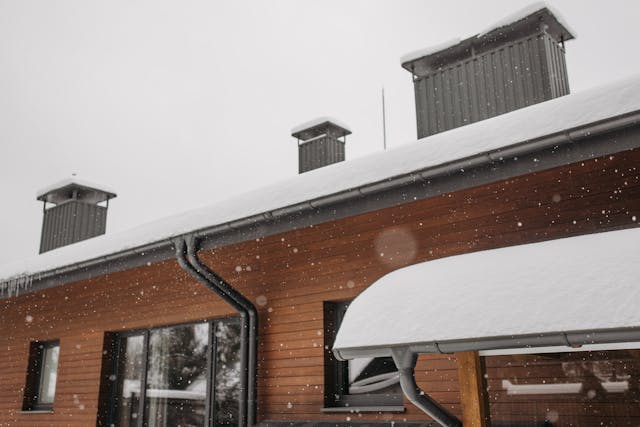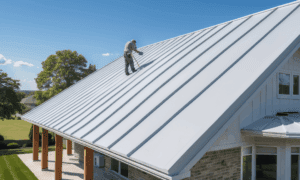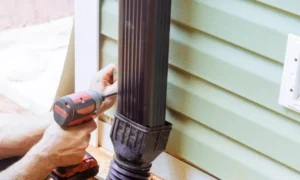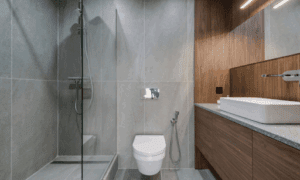Gutters play a crucial role in protecting your home from water damage, yet many homeowners don’t give them much thought—until a problem arises. Choosing the right gutter system involves more than just picking a color that matches your home; factors like size, material, and proper installation all play a role in how effectively your gutters perform.
This guide covers key considerations when selecting gutters for your home, including different materials, styles, and the differences between 5-inch and 6-inch gutters—a choice that can make a big impact on water management.
1. Why Gutters Matter
Your home’s gutter system directs rainwater away from your foundation, preventing structural damage, basement flooding, and soil erosion. Without gutters, heavy rain can cause water to pool around your home, leading to expensive repairs.
Key Benefits of a Well-Installed Gutter System:
- Protects your home’s foundation from water damage.
- Prevents soil erosion around your landscaping.
- Reduces the risk of basement flooding.
- Protects siding and exterior walls from water stains and rot.
Gutter Pros — one of the top-rated gutter companies based in Chicago — emphasizes that choosing the right gutter size and material is just as important as ensuring proper installation.
2. Common Gutter Materials and Their Pros & Cons
Gutters come in a variety of materials, each with its own advantages and drawbacks.
Aluminum Gutters
- Pros: Lightweight, rust-resistant, affordable, and available in various colors.
- Cons: Can dent easily, may not be as strong as other materials.
Copper Gutters
- Pros: Long-lasting, aesthetically pleasing, resistant to corrosion.
- Cons: Expensive, requires professional installation.
Steel Gutters
- Pros: Extremely durable, resistant to damage from debris or ladders.
- Cons: Can rust over time if not properly maintained.
Vinyl Gutters
- Pros: Budget-friendly, easy to install, won’t rust or corrode.
- Cons: Not as durable in extreme weather conditions, may crack over time.
For most homeowners, aluminum gutters provide the best balance of durability, affordability, and low maintenance.
3. 5-Inch vs. 6-Inch Gutters: What’s the Difference?
One of the biggest decisions when choosing gutters is selecting the right size. While 5-inch gutters are the standard choice for most homes, 6-inch gutters are growing in popularity due to their ability to handle larger volumes of water.
Key Differences:
- Water Capacity: 6-inch gutters can handle up to 50% more water than 5-inch gutters, making them ideal for areas with heavy rainfall.
- Roof Size Considerations: Homes with steep or large roofs benefit from 6-inch gutters, which help prevent overflow.
- Aesthetic Differences: 6-inch gutters are slightly more visible from the curb but can look more proportional on larger homes.
To learn more about which gutter size is best for your home, check out Gutter Pros’ guide on 5-inch vs. 6-inch gutters.
4. Choosing the Right Downspouts
Even with properly sized gutters, your system won’t function effectively without the right downspouts. Downspouts help move water away from your home’s foundation, preventing erosion and basement flooding.
Types of Downspouts:
- Rectangular Downspouts: The most common type, typically paired with 5-inch or 6-inch gutters.
- Round Downspouts: Offer a sleek, modern look while efficiently handling water flow.
- Rain Chains: A decorative alternative that slows down water flow but may not be ideal for high-rainfall areas.
For optimal drainage, larger gutters should be paired with wider downspouts to prevent bottlenecking.
5. Seamless vs. Sectional Gutters
Another factor to consider when installing new gutters is whether to choose seamless or sectional gutters.
Seamless Gutters
- Custom-made to fit your home, reducing the risk of leaks.
- More durable and lower maintenance than sectional gutters.
- Typically made from aluminum, copper, or steel.
Sectional Gutters
- Made from pre-cut sections that are joined together during installation.
- Easier to install as a DIY project but more prone to leaks.
- Available in a variety of materials, including vinyl.
Seamless gutters are generally the best option for long-term durability and efficiency.
6. Gutter Guards: Are They Worth It?
Gutter guards help prevent leaves and debris from clogging your gutters, reducing the need for frequent cleanings.
Pros of Gutter Guards:
- Reduce maintenance time and effort.
- Prevent clogs and improve water flow.
- Extend the lifespan of your gutter system.
Cons of Gutter Guards:
- Some types may still require occasional cleaning.
- Initial installation costs can be high.
If you’re considering gutter guards, it’s important to choose the right type for your climate and maintenance preferences.
7. The Cost of Installing New Gutters
The cost of new gutters depends on several factors, including material, size, and whether you choose seamless or sectional options.
Average Gutter Installation Costs:
- 5-Inch Aluminum Gutters: $6–$12 per linear foot.
- 6-Inch Aluminum Gutters: $8–$15 per linear foot.
- Copper Gutters: $25–$40 per linear foot.
While 6-inch gutters cost slightly more upfront, they can save homeowners money in the long run by preventing water overflow and reducing the risk of damage.
8. Finding a Reliable Gutter Installer
A professional installation is essential for ensuring your gutters function properly and last for years.
What to Look for in a Gutter Installer:
- Experience with Seamless Gutters: Not all companies specialize in seamless installations.
- Warranty on Workmanship: A reliable contractor will stand behind their work.
- Positive Reviews and Referrals: Check customer feedback to ensure high-quality service.
Gutter Pros — the experts in seamless gutter installation — recommend working with a company that provides both high-quality materials and skilled craftsmanship along with a lifetime warranty..
For additional home maintenance tips, check out The National Association of Home Builders’ guide to exterior home improvements, which provides valuable insights on protecting your home from the elements.
By choosing the right gutters and ensuring proper installation, you can safeguard your home from water damage, reduce maintenance, and improve your home’s overall efficiency.



































